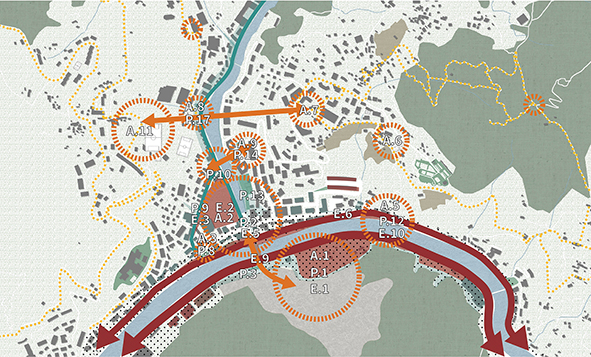Open Source Data and Strategic Project for Resilient City
DOI:
https://doi.org/10.19229/2464-9309/5132019Keywords:
open-source, data, planning, urban resilience, territorial strategiesAbstract
This contribution explores the role of information technology, relating to the representation and processing of data in open source and crowd-sourced format, for the purpose of urban planning and design process. In the research field, an experimental analysis is carried out within the Genoese neighborhood of Molassana by comparing and processing, in a single system, the traditional cartography provided by the online portals of the public administration and the data shared by users on social networks and open source platforms. The complexity of the information obtained grows a synthetic multi-layer territorial strategy, strongly linked to the local and social context.
Downloads
Article Metrics Graph
References
Andriani, C., Fagnoni, R. and Gausa, M. (eds) (2017), Med.net3 Resili(g)ence, Intelligent Cities / Resilient Landscapes – Conference Proceedings, Papersdoc, Barcelona.
Berardi, A. (2015), La città come architettura dell’informazione ed esperienza. [Online] Available at: www.trovabile.org/articoli/architettura-informazione-citta [Accessed 19 December 2017].
Bompani, M. (2016), Il rio Geirato padre di tutte le alluvioni. [Online] Available at: ricerca.repubblica.it/repubblica/archivio/repubblica/2016/02/18/il-rio-geirato-padre-di-tutte-le-alluvioniGenova07.html [Accessed 20 January 2018].
Burry, J. R. (2007), “Mindful Spaces: Computational geometry and conceptual spaces in which designers Operate”, in International Journal of Architectural Computing, vol. 05, issue 04, pp 611-624.
Candito, C. (2016), Modelli e immagini per la rappresentazione dell’architettura, Aracne, Ariccia (RM).
Commissione europea (2012), Orientamenti in materia di buone pratiche per limitare, mitigare e compensare l’impermeabilizzazione del suolo, Ufficio delle pubblicazioni dell’Unione Europea, Lussemburgo. [Online] Available at: ec.europa.eu/environment/soil/pdf/guidelines/pub/soil_it.pdf [Accessed 20 April 2019].
MVRDV (1999), Metacity/Datatown, 010 publishers, Amsterdam.
Deutsch, R. (2015), Data-driven Design and Construction – 25 strategies for capturing, analyzing, and applying building data, John Wiley & Sons Inc., Hoboken, New Jersey.
Galli, A. (2015), “Progettazione parametrica della città attraverso gli open data”, in Urbanistica Informazioni, Special issue IX, pp.37-40.
Galli, A. (2014), “Tools and methods for parametric urbanism”, in Tedeschi, A. (ed.), AAD-Algorithm Aided Design, Le penseur, Brienza (PZ), pp. 478-481.
Gausa, M., Guallart, V., Muller, W. and Prat, R. (eds) (2003), Hicat Research Territories, Actar, Generalitat de Catalunya, GENCAT, Barcelona.
Geoportale, Regione Liguria. [Online] Available at: geoportal.regione.liguria.it [Accessed 20 January 2018].
Holling, C. S. (1973), “Resilience and Stability of Ecological Systems”, in Annual Review of Ecology and Systematics, vol. 4, pp. 1-23.
Fusero, P., Massimiano, L., Tedeschi, A. and Lepidi, S. (2013), “Parametric urbanism: A new frontier of Smart City”, in Planum, the Journal of Urbanism, n. 27, vol. 2, pp. 1-13.
Open Knowledge (2015), Open Definition 2.1. [Online] Available at: opendefinition.org [Accessed 18 January 2019].
Ratti, C. (2014a), Decoding the city: urbanism in the age of big data, Birkhauser, Basilea.
Ratti, C. (2014b), Smart city, smart citizen, Egea, Milano.
Trueheart, E. W. (2012), Building institutional capacity for data-informed decision making, vol. 3, Public Agenda, New York. [Online] Available at: www.achievingthedream.org/sites/default/files/resources/ATD_CuttingEdge_No3.pdf [Accessed 18 January 2019].
UN Global Pulse (2016), Integrating Big Data into the Monitoring and Evaluation of Development Programs. [Online] Available at: unglobalpulse.org/sites/default/files/IntegratingBigData_intoMEDP_web_UNGP.pdf [Accessed 18 January 2019].
Woods Ballard, B., Wilson Udale-Clarke, H., Illman, S., Scott, T., Ashley, R. and Kellagher, R. (2015), The SuDS Manual, CIRIA, London.

Downloads
Published
How to Cite
Issue
Section
License
This Journal is published under Creative Commons Attribution Licence 4.0 (CC-BY).
License scheme | Legal code
This License allows anyone to:
Share: copy and redistribute the material in any medium or format.
Adapt: remix, transform, and build upon the material for any purpose, even commercially.
Under the following terms
Attribution: Users must give appropriate credit, provide a link to the license, and indicate if changes were made; users may do so in any reasonable manner, but not in any way that suggests the licensor endorses them or their use.
No additional restrictions: Users may not apply legal terms or technological measures that legally restrict others from doing anything the license permits.
Notices
Users do not have to comply with the license for elements of the material in the public domain or where your use is permitted by an applicable exception or limitation.
No warranties are given. The license may not give users all of the permissions necessary for their intended use. For example, other rights such as publicity, privacy, or moral rights may limit how you use the material.


















































































